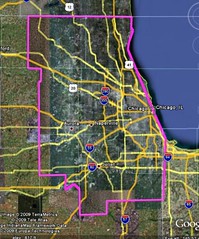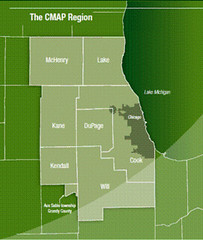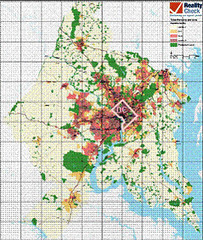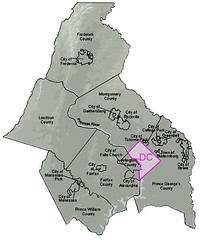It’s time to adjust to the new metropolitan reality (continued)

Posted March 26, 2009 at 1:26PM
One of the recurring themes of my writing (for example, here) has been that, to achieve sustainability in our cities, suburbs, and rural areas, we need to get beyond the accidents of history that comprise our local jurisdictions. Environmental, economic, and social patterns do not respect jurisdictional lines, and it is essential that our solutions not be confined to them, either.
"Chicagoland," for example, comprises parts of eight counties in northeastern Illinois. When I was researching a book in the 1990s, I ran across one researcher's account that put metropolitan Chicago's number of legal jurisdictions at 267 separate entities, with around 1200 quasi-jurisdictions of various kinds. (And that may not even include the portions of metro Chicago that are in Indiana; most representations of metro Chicago don't.) Those numbers may be even higher now.
In my own life, my wife and I live in Washington, DC; my bike is currently in the shop for repairs in the state of Maryland; my wife just called me from the commonwealth of Virginia, where she works. She passes through several municipalities every day just getting to work and back, frequently stopping along the way for errands. I'm sure readers are nodding their heads: none of this is in the least bit unusual.
But, for the most part, unfortunately, policy decisions are made at the most local of levels - one of those 267 legal entities - or at the state level. With few exceptions, metropolitan areas have little in the way of legal authority. Especially for transportation and environmental issues, this is dysfunctional. It is also problematic that, for the most part, state and federal government agencies have no official relationship with metropolitan areas, and state and federal authorities themselves are fragmented in silos. It's a mess.
Here are two views of metro Washington:
Fragmented jurisdictions are also a major cause of sprawl, by the way, especially as they compete with one another for new development to increase their tax revenues - sometimes actually diminishing those revenues as the jurisdictions offer tax breaks or other subsidies to out-compete their neighbors.
This is far from an easy problem to address. But I am encouraged that President Obama has issued an executive order creating an Office of Urban Policy with an agenda to focus on entire metropolitan regions, not just cities. It would be even better if he called it an Office of Metropolitan Policy, but I'm not going to quibble about semantics.
Writing for his syndicate Citiwire, Neal Peirce is both cautious and hopeful:
"Obama's selection of Bronx Borough President Adolfo Carrion to head the new office was a touch unsettling to some supporters of a more metro-oriented urban approach. They worry that Carrion's experience is entirely New York City-related, without background either in city-suburban ties or federal policy . . .
"[But] the long-term possibilities for the new office are intriguing. It can encourage the administration's macro-economists to take seriously the wealth-generating capacity of metros. Long-neglected Census tools can be ramped up to give metros a better compass on their status, mixing transportation, housing, energy and workforce issues. Federal policies that unintentionally hamper the work of metros can be singled out, targeted for change.
"[Obama adviser Robert] Weissbourd even advocates inviting civic and government leaders of individual metros to develop customized plans to connect their infrastructure, workforce, housing,
transportation and business challenges, and then getting the new White House office to clear the way for positive cross-departmental federal response."
Peirce points out that just the 100 largest (of 363 total) metro regions in the US today account, together, for 92 percent of air passenger boardings, two-thirds of major research universities, 75 percent of workers with graduate degrees, and 78 percent of all patents. They are major economic units, but only when considered across local jurisdictional lines. (Metro Twin Cities, Minnesota, shown at right.)
The president campaigned on the issue, noting that "Washington remains trapped in an earlier era, wedded to an outdated 'urban' agenda that focuses exclusively on the problems in our cities, and ignores our growing metro areas." He is now attempting to fix that, and the challenges will be immense. (Watching his news conference the other night, I was mostly struck by the fact that I wouldn't want his job for all the tea in China.) But at least it's a start.



